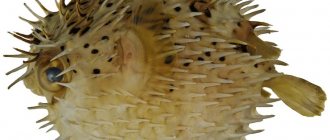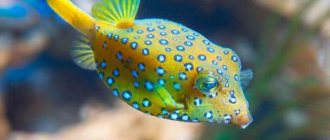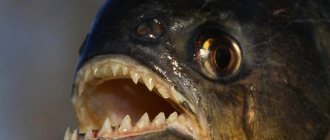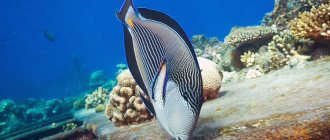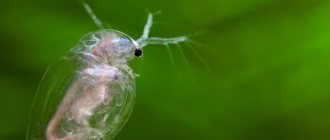The stickleback fish belongs to the ray-finned family, the order of sticklebacks. Its distinctive features are the absence of scales, the presence of several spines on the back (their number depends on the species), two spines on the abdomen and fused pelvic bones, forming the so-called abdominal shield.
The stickleback fish uses its needles in case of danger. In a calm state, the spines are adjacent to the body, but when attacked by a predator, it spreads them out so that they stick into the enemy’s mouth. Since these fish are well protected, they have practically no enemies. They are very voracious, so any bait is suitable for fishing. With a significant number of individuals in the population, they stay in large flocks.
This little fish lives only three to four years. It grows to the size of an adult by one year, and at the same time becomes sexually mature.
Classification and description of stickleback fish
Based on the type of water, they are divided into freshwater, seawater and anadromous.
The freshwater fish lives and breeds only in fresh water bodies and never enters the sea.
The marine fish lives in the sea and goes to coastal waters to spawn.
The migratory species lives in sea water and breeds in fresh water bodies. If after spawning it does not have time to leave the river, it dies. Newborn individuals gradually move into the sea.
There are several types of smelt, which differ in the number of needles on the back: three-spined, four-spined, nine-spined. In addition, they also include sea stickleback, southern stickleback and brook stickleback.
Puffer fish
What is the most poisonous fish in the world? The Guinness Book of Records lists the most poisonous fish in the world as fish from the pufferfish family, or dog fish. The caviar, skin and liver of puffer fish (dogfish) contain a dose of tetrodotoxin that is lethal to humans. The fish does not produce the dangerous poison itself, but rather secretes it from its diet and accumulates it. Encyclopedia Britannica lists fish as one of the ten most dangerous fish for humans.
Where does the most poisonous fish in the world live? Puffer fish has a wide range. It can be found in the northwestern regions of the Pacific Ocean, as well as in fresh Asian rivers of the Indo-Pacific basin.
Puffer fish: Wikipedia
Fish are well known not only to biologists and gourmets around the world. The dogfish is used to produce a popular Japanese dish, fugu. Most often it is prepared from the most common and very poisonous type of fish - brown rockfish. To prepare this dangerous delicacy, Japanese chefs have to study for a long time and must obtain a government license.
An error in preparation can lead to painful death from paralysis and suffocation. The paralyzed person remains conscious until death. There is no antidote for tetrodotoxin, although a person can be saved using artificial life support. Every year, about 5 people die because of the dangerous delicacy fugu.
Where does it live?
Especially a lot of stickleback can be found in the Baltic and White Seas. It is found in the rivers of Western Siberia, in the lower reaches of the Dnieper, in the Northern Donets, in the reservoirs of the Black, Azov and Caspian Seas, in the ilmens in the Astrakhan region. Can be found in the Volga and rivers of the Volga basin.
Stickleback fish loves quiet places with calm currents. These can be small grooves, rivers, lakes with a sandy or muddy bottom and banks covered with grass.
Three-spined and nine-spined ones live in all European countries. In Russia, stickleback habitats are rivers flowing into the White and Baltic seas, rivers of the Far East, reservoirs of the Leningrad region, and Lake Onega.
Stickleback lives along the entire coast of Europe, from Norway to the Bay of Biscay. Its habitat is marine areas off rocky shores.
The southern small one is found in desalinated areas of the Azov, Black and Caspian seas, as well as in the rivers that flow into them. Also lives in the lower reaches of the Dnieper and Northern Donets.
Economic importance
Previously, this small fish was hunted in the Baltic, White and Azov seas, as well as in Kamchatka. High quality fish oil and feed meal were obtained from it. In addition, stickleback was used as animal feed and as fertilizer for fields. In besieged Leningrad, fish oil rich in carotenoids was used in hospitals to treat wounds and burns.
Currently, stickleback is a fish whose economic importance is very insignificant. She eats absolutely everything, thereby having a negative impact on the offspring of valuable commercial breeds.
Description of stickleback reproduction
Fish spawning time is most often April-May. A few days before this, they change color - they become brighter. Their fertility is low - only 100 eggs laid.
The peculiarity of this species is that the stickleback fish equips a nest for laying eggs. And it is not the female who does this, but the male. He digs a hole in the sand with his mouth, then transfers pieces of silt, algae, grass there and lays out the bottom. For strength, all this is held together by mucus secreted from the sides of the fish. The ball-shaped nest has two holes located opposite each other. Sometimes it is half hidden in the mud and is difficult to detect.
After the place is equipped, the male returns to the flock, selects a female ready for laying and drives her into the nest through one of the holes. The female lays eggs and exits into another hole, after which the male enters the nest and fertilizes the laid eggs with milt.
After this, the male remains at the nest and guards it, keeping enemies away. This continues for about two weeks until all the young fish that have hatched from the eggs leave the nest. And before that, he closely monitors the offspring, not allowing them to go far from the nesting site.
Zebra fish
The zebra fish, or striped lionfish, is a species of ray-finned fish of the scorpionfish family. These are predatory fish armed with poisonous spines. The maximum size of lionfish reaches 48.8 cm, on average these fish grow up to 45 cm. Zebra fish live in the tropical regions of the Indian and Pacific oceans. The largest populations are observed off the coasts of Japan, China and Australia.
Zebra fish: Wikipedia
The fish uses dangerous spines for self-defense. When threatened, she turns over and injects with poison. A person who receives such an injection feels severe, sharp pain at the injection site and in the head. The poison causes vomiting and difficulty breathing. Without timely medical care, a person dies.
Zebra fish has very tasty and tender meat. Because of this, it becomes an important fishing target. Today, the lionfish population is not in danger, but the zebra fish itself poses a serious threat to coral reefs and their inhabitants.
Nutrition
Stickleback fish eat a wide variety of foods. These are mainly small inhabitants of reservoirs, namely crustaceans, worms, insect larvae, plankton, benthos (organisms living at the bottom of a reservoir). In addition, they are able to eat eggs and young individuals of other fish and even their own species.
They hunt moving prey at night. Hunting is especially successful during the full moon, since they require at least a small amount of light. The stickleback is very active and chases small fish. Having discovered the prey, it rushes towards it, quickly grabs it with its jaws, stretching them forward, and closes its sharp teeth, leaving the victim no chance of salvation. Other sticklebacks, seeing such a picture, rush to her in a school in the hope that they, too, will get food.
Diseases - prevention and treatment
Sticklebacks are fairly unpretentious and persistent fish. Their illnesses mainly have an external source.
Types of diseases
Sticklebacks caught from natural bodies of water can develop dermatomycosis, caused by mold fungi of the Saprolegnia and Achlya species. This can be caused by stagnant water and insufficiently fresh food. Unwashed plants can also become a source of the disease. The fish begin to scrape against the bottom, decorations and plants. Their behavior loses vivacity, their movements become more sluggish. Later, the fungus appears as a coating on the body and fins, similar to cotton wool. Sick fish are immediately separated and placed in a 2% salt solution or a weak solution of potassium permanganate at the rate of 1 g per 100 liters of water. The aquarium must be completely disinfected, including washing the plants and boiling the sand and decorations.
IMPORTANT : As a preventive measure, it is advisable to place all fish in the same 2% salt solution for at least half an hour before planting them in the main aquarium.
The fish are also susceptible to diseases caused by parasites – ergasilosis and argulosis. These are small crustaceans of the corresponding species, which fish become infected with from crustaceans that act as carriers. Ergasilids parasitize on the gills, and argulus parasitize on the skin. Sick fish eat poorly, lose weight and become restless. Treatment is carried out using a solution of chlorophos or potassium permanganate.
How to catch
They catch stickleback from the bottom. It is of little interest to fishermen because it has no nutritional value. Rather, it is an amateur activity, for example, for children and teenagers. Since she is very voracious, fishing will be easy.
What to use to catch stickleback fish? She bites on maggots, worms, fish eggs, and even on a bare hook. In winter, colored jigs of various shapes and sizes are used as bait with replantings of bloodworms, worms, and maggots. Due to its size, this little thing is almost never found online.
Fishermen consider it a trash fish, but it still has some benefits. Technical fat is obtained from it, feed flour and fertilizer for fields are made.
There are fans who keep it in an aquarium at home.
Habitat
Stickleback is divided according to water type. Freshwater representatives never enter the sea. They are found and breed only in fresh water bodies. Marine fish live in sea water, but during the spawning season they swim to coastal areas.
Many stickleback fish live in European reservoirs and Western Siberia. There are very few in the Volga itself and its waters. The largest numbers of these representatives are observed in the rivers of the basin:
- Baltic;
- White;
- Black;
- Azovsky;
- Caspian Sea.
Koluha fish is widespread in the Dnieper and Northern Donets. To catch it, you need to look for places with a calm and slow current. She prefers small lakes and rivers with grassy banks and muddy bottoms. It can even live in ditches. In reservoirs with a large population of fish, they live in large schools. They begin to attack any object that falls into the water.
Because of their sharp and strong spines, sticklebacks are too tough for most inhabitants of reservoirs. With the help of spikes, they arrange a showdown among themselves. Sticklebacks eat other people's eggs, and in large quantities. Due to the absence of enemies, the thorn fish is able to breed offspring without hindrance. This fact threatens the existence of other more peaceful inhabitants of the reservoir. The lifespan of sticklebacks is quite short and is only 3-4 years.
Stickleback nutrition
This small fish is endowed with an excellent appetite. She eats any food, however, the basis of her diet consists of:
- worms;
- crustaceans;
- plankton;
- insect larvae;
- organisms living at the bottom of water bodies.
Since they are predators, they eat other types of fish, their eggs and even their fellow fish. The time for hunting is night. They choose moving fish, behave actively, and chase smaller individuals. Hunting is best during the full moon, when there is additional lighting.
At the sight of prey, the stickleback quickly rushes at its prey, capturing it with its jaws. Sharp teeth leave the victim no chance of survival. Fellow members of the pack also rush to the site of the attack in the hope of feasting on the captured prey.
https://youtube.com/watch?v=K8xRUblflh0
Reproduction and offspring
The spawning period for sticklebacks begins in early spring in April - May. At this time, the color of her body becomes much brighter. The duration of spawning lasts for 1 month. Such small fish are characterized by good fertility. She builds her nest for laying eggs at the bottom of the reservoir. The male himself equips it by digging a hole. He takes sand into his mouth and takes it to the side.
Various blades of grass and pieces of algae are used as building material. The male glues them into a dense ball, secreting saliva from the sides of the body. In a finished dwelling the size of a man's fist, he digs a tunnel.
The female is invited to the nest by the male, where she must lay eggs, on average 100-120 eggs. After this, the partner kicks her out of the nest. It independently protects the clutch after fertilization, as well as the fry after their appearance for 10-14 days.
The spawning period for sticklebacks begins in early spring in April - May
Young offspring are constantly under threat from their own parents. The female can always eat the eggs, and the male can later profit from the young. However, during the spawning period, the esophagus of the reproductive offspring becomes overgrown.
Fishing methods
For fishermen, this type of fish is not of great interest, since it has no nutritional value. Most often, children catch small fish from the bottom. Since it is voracious, such an activity will bring many pleasant moments, because the stickleback will constantly peck.
She bites well on eggs, maggots, worms and even swallows a bare hook. During winter fishing, colored jigs of various shapes and sizes are used. A worm, bloodworm or maggot of your choice is added to them. After catching it, you must carefully pick it up so as not to prick yourself on the sharp thorns.
For most fishermen, stickleback is a trash fish. However, it is used to produce high quality feed meal, fish oil and fertilizer for fields. Some aquarium fish lovers put it in home containers.
Interesting
It turns out that a monument was erected in honor of the stickleback. This sculptural composition is located in Kronstadt on the island of Kotlin and is called “Monument to the Siege Stickleback.” In besieged Leningrad, all commercial fish in the Gulf of Finland were caught, and only one small fish remained, which was not eaten in peacetime and was considered garbage by fishermen. It so happened that during the years of the blockade, stickleback fish saved thousands of people from hunger. The small spiny fish did not fall into the nets, so they caught them with shirts, nets, and bags. Cutlets were fried from it in its own fat and fish soup was cooked.
In the second medical hospital of Leningrad, stickleback fat was used to treat wounds and burns of soldiers.
The idea of the monument arose back in 1957, but the project was submitted for consideration only in 2004. On the initiative of Kronstadt veterans, it was created and installed near the Blue Bridge on the wall of the Obvodny Canal - three bronze sticklebacks on metal waves and a memorial plaque with lines from the poem “Blockade stickleback” by the poetess Aminova M. The author of the monument is sculptor N.V. Chepurnoy. The opening took place in 2005 on the eve of the 60th anniversary of the Victory.
Description by type
All representatives have spines on the back in front of the fin in the absence of a ventral fin, which is sometimes replaced by a spine or several soft rays. A special feature of the fish is the formation of an abdominal shield due to the fusion of the pelvic bones and the absence of scales. It scares away predators with its spikes, which spread out and then plunge into the enemy’s mouth. Ruffled needles are also observed in the event of any other danger.
This little fish has already managed to become famous. During the blockade years during the Great Patriotic War, there were practically no fish left in the Gulf of Finland and the canals of Leningrad and Kronstadt, except for the nimble stickleback. She was caught using nets and bags of shirts. Having become one of the few available products, the fish saved many lives of blockade survivors. Years later, on May 8, 2005, grateful descendants erected a monument to the siege stickleback on the territory of Kronstadt.
Three-Eyed
The spiny three-spined stickleback is “armed” with three spines on its back. The lateral parts of the body are protected by 24-30 transversely running bone plates. They act as a replacement for scales and gradually begin to narrow in the tail area. The same scales can be found in the area of the back between the back of the head and the beginning of the caudal fin.
Fish live on average 2-4 years, maximum 5 years. The length of adult individuals is 5-6 cm, some reach 10-11 cm. Body weight can reach 8-9 g. They grow quite quickly and after 3-4 months. approaching the length of sexually mature individuals. They mature after reaching 1 year.
The back is colored greenish-brown, although the sides and abdomen are silvery. In this case, the color is largely determined by the physiological state, age, season or area of distribution. So, in winter, stickleback fish has a silvery-grayish tint, and in summer the color changes to greenish and brown with a silvery tint. The coloration of males and females is usually identical, except during breeding time. On such days, the males become reddish on the underside, and the head also takes on the same shade. The back will be bluish, and the eyes will be bright blue. During the period of laying eggs, the female looks fascinating - dark stripes appear across the back and sides, and the bottom of the body acquires a yellowish tint.
The fish are distinguished by an elongated and laterally compressed, spindle-shaped body. The caudal peduncle is short. On the pointed head there is an elongated snout, which, however, is shorter than the postorbital segment. It is distinguished by a small retractable mouth and gill membranes, fused into the area of the interbranchial space without forming a fold in the transverse direction. There are 3 spines in front of the dorsal fin, which gives it its name. After raising the dorsal and ventral fins, they are closed with a latch - this creates a threat to enemies.
Four-needle
Common in the Western Atlantic, the four-spine fish prefers coastal sea waters, although it can also be found in the waters of Canadian lakes. It is distinguished by a bare brownish-olive or greenish-brown body in its upper part and a silvery belly, on which reddish pelvic fins flaunt. A characteristic feature is the presence of four spines, the absence of bone plates on the sides and bare skin. The average length of the body is 4-5 cm. The standard diet consists of planktonic crustaceans. Spawning time May – end of July. During the incubation period, the egg laying is under the protection of the male.
Nine-needle
Individuals grow up to 5-6 cm in length, sometimes up to 9 cm. The description is characterized by the presence of a moderately elongated, naked body with a thin caudal peduncle and a short snout. Due to the fusion of the gill membranes, a wide free fold is formed. It is located in the transverse direction relative to the interbranchial space. The dorsal fin is located on top of the anal fin. Moreover, they are placed symmetrically. The fish is seriously armed with 9-10 (in some individuals 7-12) not too large, but sharp spines. They are directed in different directions in a zigzag shape. This terrifying appearance is complemented by pelvic fins reduced to needles. A spine is found in front of the anal fin. The keel is formed by the bony scutes of the caudal peduncle.
The stickleback is distinguished by its brownish-green back, on which there are wide black stripes along the body, and a silvery belly. During the spawning period, the males of this species change color - the lateral and ventral parts turn completely black, and the spines on the belly turn white.
The average life expectancy is 3-4 years upon reaching sexual maturity at the end of the 1st year after birth. Batch-type spawning lasts from July to August. The fertility of sticklebacks is relatively low (up to a couple of hundred eggs), but it is offset by the care of adults for their offspring, which ensures a significant level of survival of the fry. The male constantly guards the nest.
This spiny fish is very voracious. Its diet is formed by small bottom invertebrates. Stickleback feeds on the eggs of its brethren and other species, as well as their fry. It is not caught on an industrial scale.
There is no economic value. It is an active absorber of commercial fish eggs and competes with them for their diet. The small predator quickly pecks at live bait.
sea stickleback
The description of the fish is quite remarkable. She has a very elongated body. The caudal peduncle is long and thin. It is distinguished by the pentagonal appearance of the frontal and middle parts of the body with a transverse cut, as well as by a long and thin snout. The fin on the back is decorated with 14-17 individual spines and 6-7 connected rays. In the area of the anal fin there is 1 spiny ray with 6-7 connected rays. The pelvic fin is distinguished by the presence of a spiny and short ray. These characteristic features are clearly visible in the photo. The fin in the caudal zone is small in size, its rear edge is rounded.
Stickleback fish can have different body colors, depending on their distribution area. It may be green or brown. The front side of males is distinguished by a brass-yellow hue. During the spawning period, they acquire a bluish tint. Adults grow up to 18-20 cm, but can reach 22 cm in length.
Southern small
It grows up to 7 cm in length and weighs about 1 g. Life expectancy is 2-3 years. In appearance, the stickleback lives up to its name. Instead of scales, there are small bone plates on the body. In front of the fin on the back there are separately protruding spines, the number of which is 8-11 units. They are inclined in different directions alternately. The ventral and anal fins are decorated with one needle.
The body is taller and shorter with a dark or olive greenish back. The side is light green. During spawning, males acquire a black appearance, which is clearly visible in the photo.
Prefers to inhabit areas of reservoirs that are overgrown with submerged aquatic vegetation. Shallow standing or semi-standing waters are more suitable for it. This spiny fish is not prone to forming schools. The diet includes benthos and zooplankton, and can feed on eggs and vegetation. Reaches sexual maturity in the 2nd year. The spawning period is from late April to June. Kolukha actively protects its offspring.
Ruchevaya
Brook stickleback fish grows up to 6 cm in length. It is a fairly active and numerous species. It looks like its brothers, but there are 4-6 spines on the back in front of the fin. Males turn bright red in spring.
Toadfish
The toadfish is a predatory species of the toadfish genus of the batrachidae family. They live in the western regions of the Atlantic Ocean. The body length of the fish is about 40 cm, weight reaches 2 kg. The favorite hunting tactic of these fish is to burrow into the muddy or sandy bottom. Because of this, you can accidentally step on the fish. The fish has poisonous spines on its back, the injection of which is very painful. The fish makes loud beeping sounds, which can be painful to the ear up close.
Toadfish: Wikipedia
Toadfish not only pose a danger to humans, but sometimes served him for scientific purposes. In 1998, NASA launched several toadfish into space on the space shuttles Columbia and Discovery and observed the behavior of marine inhabitants in zero gravity.
Trunk fish
The bodyfish class of ray-finned fish is a family of toxic fish. Due to the characteristic shape of their “beak” they are called trunk fish. The body length of different species varies from 11 to 55 cm. The body is protected by a shell made of hexagonal-shaped bone plates. The skin is bare and covered with mucus. Bodyfish live in tropical regions of the Pacific, Indian and Atlantic oceans. They can be found in tourist areas of the Red Sea and off the coast of Australia.
Trunk fish: Wikipedia
Fish are capable of producing a special neurotoxin - pachutoxin. It spreads through the skin and mucus of the animal, quickly dissolves in water and poisons surrounding fish. Since the poison is contained in the tissues of fish meat, it is dangerous to eat. Proper processing neutralizes toxins and makes fish meat edible. Fish occupies an important place in the local fishery.
A little about three-spined stickleback
The body of the stickleback, like that of seahorses, is covered not by scales, but by bony plates, forming a hard and strong shell around the fish. After all, both species belong to the order Sticklebacks, but to different families. Stickleback is a member of the stickleback family, of which 12 species are known. In the vicinity of St. Petersburg there lives a three-spined stickleback, and it was she who found herself in the role of a “saving angel” during the days of the blockade.
Appearance of three-spined stickleback
Three-spined sticklebacks are found in fresh water bodies and in the sea. The length of the freshwater form is 4-6 centimeters. The body is elongated, but quite high, slightly compressed from the sides. The short caudal peduncle passes into the caudal fin, which is not divided into lobes. The body, instead of scales, is protected by bone plates, and it seems that the fish is encased in a shell. The slightly pointed head has large, expressive eyes.
In the photo of the stickleback, three sharp large spines located in the center of the back are clearly visible. Based on their number, the fish got its name - three-spined. The dorsal fin is located behind the spines. But this is not all the “weapon” of this little fish. Instead of pelvic fins, she also has spines. Raised spikes are a very formidable and serious weapon.
Formidable weapon - thorns
When the stickleback fish is in a calm state, the spines fit tightly to the body.
When there is danger or attack from a predator, the spines rise and spread out in three directions - up from the back and to the sides from the abdomen. In this position, they plunge into the predator's mouth.
In fights between males before spawning, this weapon is also successfully used. It often happens that the winner rips apart his opponent with the help of his spikes.
Coloring and sexual differences
The color of the stickleback is changeable, and it is influenced by several factors: age, physiological state, habitat and season:
- young specimens are silver in color;
- in winter the color is silver-grayish, and in summer it is greenish-brownish with a silvery tint.
Usually males and females do not differ in color. But during the breeding season, the back of the male becomes bluish, the lower part of the head and body turns red.
The females also transform - dark transverse stripes appear on the sides of the body and on the back, and the abdomen acquires a pale yellow color. After spawning is completed, the coloring becomes the same.
Reproduction
The nest is built on the shallows among aquatic plants, provided that there is a moderate current there. A hole is dug at the bottom: the male picks up sand with his mouth and takes it to the side.
The building material is scraps and remains of plants, which the male fastens with mucus from the sides of his body. The nest is fixed on the stems of underwater plants and is immersed in the mud, so it is invisible. A photo of a male stickleback shows the process of collecting plant debris to build a nest.
When the nest is ready, the male pushes the female into the nest, who stays there for a few seconds and manages to lay her portion of eggs (about 100 eggs). The male immediately kicks her out and hurries to fertilize the eggs. Then he looks for another female and does the same with her. The most agile males can collect eggs from six to seven females (150-180 eggs).
Then it's time for the male to get busy:
- While guarding the nest, he attacks everyone who happens to be nearby.
- Corrects and repairs the nest.
- Provides developing eggs with fresh water - fans them with pectoral fins.
The three-spined stickleback does not live long - 3-4 years. It begins to reproduce at the end of the first year of life (in freshwater bodies). Although she is small, she is very voracious - a kind of small predator. Its food: fry and eggs of other fish (including its own species), worms, crustaceans, insect larvae.
How they caught stickleback during the blockade
Residents of besieged Krondstadt used improvised devices to catch stickleback instead of nets: shirts, bags, baskets, T-shirts, butterfly nets with very small cells.
The fish soup and cutlets made from small spiny fish turned out to be tasty and, most importantly, nutritious. This is such a fish - blockade stickleback.
Bronze fish on metal waves
Three bronze fish and metal waves - this is what the monument to the siege stickleback looks like, located above the water flow of the Obvodny Canal next to the Blue Bridge on Kotlin Island in Krondstadt.
Four lines from a poem by Maria Aminova, a Krondstadt poetess, are written on the memorial plaque.
In 2012, the monument to the siege stickleback in Krondstadt was inscribed in the “Book of Memory of the Great War.” According to tradition, every year on January 27 (the day the siege of Leningrad was lifted), the grandchildren and children of the siege survivors bring flowers to the monument. And amateur fishermen have developed their own tradition of visiting “bronze sticklebacks” before fishing. This is a sign that the fish will bite better.
